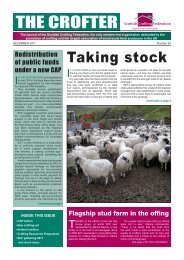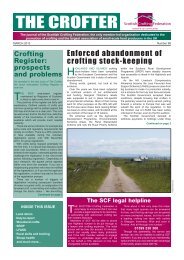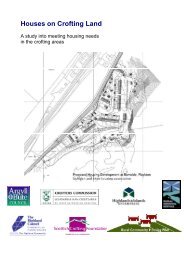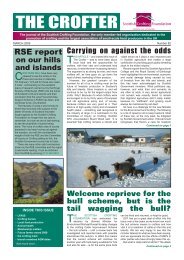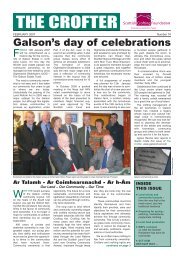Crofter 97 - Scottish Crofting Federation
Crofter 97 - Scottish Crofting Federation
Crofter 97 - Scottish Crofting Federation
Create successful ePaper yourself
Turn your PDF publications into a flip-book with our unique Google optimized e-Paper software.
22<br />
Mary’s memories<br />
T<br />
HESE TWO little books by Mary Keith,<br />
subtitled Nursing in Jura 1963-1993<br />
and Living and crofting at Keils, Jura,<br />
present an entertaining reminder of life in a<br />
west-coast island crofting community in the<br />
second half of the last century.<br />
The author was a key fi gure in Jura during<br />
her thirty years as district nurse and midwife,<br />
a period in which the NHS was changing, as<br />
was the island itself. When Mary fi rst started<br />
nursing there were 31 children from babies to<br />
school age. After eleven years that number<br />
had declined to just a few. Mary herself had<br />
to travel to Glasgow to give birth by boat,<br />
bus, then train. When the seas were rough a<br />
lifeboat was used.<br />
Mary Keith’s modest recounting of her<br />
sometimes hair-raising adventures and<br />
achievements around the island and trips to the<br />
mainland, plus the pictures she paints of local<br />
characters and their foibles, makes a fascinating<br />
read. As district nurse, Mary was on call 24<br />
hours a day, every day of the week. In addition to<br />
midwife services, she provided the “last offices”.<br />
Mary’s crofting recollections in the second<br />
book start in the days before electricity,<br />
phones or many cars on Jura. Some homes<br />
had no running water inside.<br />
Every day she hand milked four cows, before<br />
THE CROFTER, DECEMBER 2012<br />
the advent of a small milking machine. There<br />
is an amusing tale of Mary’s mother having to<br />
wear Mary’s coat before one cow would let her<br />
milk down to the unaccustomed milkmaid.<br />
The eternal cycle of the crofting year is<br />
detailed, with neighbours helping each other<br />
at lambing, planting and lifting tatties, peat<br />
cutting, hay making – fi rst with a horse-drawn<br />
cutter which was later converted to be pulled<br />
behind a tractor.<br />
The book ends with a collection of humorous<br />
sayings of local character Donald Black.<br />
Even those who do not know the Isle of Jura<br />
will fi nd much to love in these books. They will<br />
make an ideal Christmas stocking present<br />
for anyone interested in the Highlands and<br />
Islands and crofting, and are available for £6<br />
each directly from Mary Keith at:<br />
Braigh Bhaille<br />
6, Keills, Craighouse<br />
Isle of Jura Tel: 01496 820 214<br />
<strong>Crofting</strong> Connections: the Kenyan connection<br />
Pam Rodway reports<br />
H<br />
UGHIE DONALDSON, Karen<br />
MacRae and Maria Scholten<br />
represented SCF at Salone del<br />
Gusto/Terra Madre this October.<br />
The spectacular global exhibition<br />
showcased some of the world’s best foods<br />
saved by Slow Food through the Ark of Taste<br />
and the Presidia.<br />
The highlight of the SCF stand was a display<br />
and tasting of four Ark of Taste products with<br />
crofting roots – beremeal bannocks, Shetland<br />
reestit mutton, Shetland cabbage and<br />
Shetland black tatties.<br />
We were delighted to renew our contact<br />
with Samuel Muhunyu, leader of the Kenyan<br />
delegation and head of NECOFA (Network<br />
for Ecological Farming in Africa), who had<br />
met Norman Leask and Neil MacLeod at<br />
Terra Madre 2008. Samuel was looking for<br />
a project with which to link the NECOFA<br />
school gardens initiative, so we told him about<br />
<strong>Crofting</strong> Connections. In November 2010,<br />
Samuel visited <strong>Crofting</strong> Connections schools<br />
in the Highlands and Orkney and attended the<br />
<strong>Crofting</strong> Connections reception in the <strong>Scottish</strong><br />
Parliament.<br />
The school gardens in Kenya initiative<br />
aims to encourage positive attitudes to<br />
food, agriculture and the environment and a<br />
greater understanding of the connection of<br />
all three among the nation’s youth. It teaches<br />
sustainable agriculture and food nutrition as<br />
the basis for creating stable livelihoods in<br />
communities across Kenya. The gardens also<br />
act as demonstration and seed multiplication<br />
centres for the entire community, thus<br />
contributing towards food security and<br />
biodiversity conservation. The project was<br />
initiated by NECOFA in collaboration with the<br />
Slow Food central rift convivium and the Slow<br />
Food foundation for biodiversity in 2005.<br />
In Kenya agriculture contributes about 40%<br />
to GDP and provides employment to over 70%<br />
of the national workforce. However, it is not<br />
given suffi cient emphasis in school curriculum;<br />
and over 50% of the youth leaving schools<br />
without continuing in further education end<br />
up in rural areas unprepared for a career as<br />
small-scale farmers. Students are encouraged<br />
to replicate the school garden activities at<br />
home, bringing benefi ts of increased food<br />
security to the entire community.<br />
Both <strong>Crofting</strong> Connections and the NECOFA<br />
school gardens initiative work with schools<br />
in remote rural areas, where agriculture and<br />
horticulture, including small-scale subsistence<br />
farming and crofting, account for a large part<br />
of the local economy. The two projects have<br />
several aims in common.<br />
The schools partnership will enable pupils<br />
in both projects to link their local community<br />
involvement with wider global issues,<br />
including the challenges of climate change<br />
and to generate international understanding.<br />
Schools have already started to make links<br />
with each other online and we hope to arrange<br />
exchange teacher visits, starting in 2013.<br />
So, at Terra Madre 2012, Hughie Donaldson<br />
and I met with members of the Kenyan<br />
delegation – Samuel Muhunyu, Jane Karanja,<br />
Kenyan school gardens project coordinator,<br />
Maasai chief Samuel Sekeu from Baringo,<br />
Agnes Salim from the remote Mau forest<br />
community and Amos Gachuki, one of the<br />
head teachers, to discuss the next steps. We<br />
enjoyed the Shetland Ark of Taste products,<br />
with Hibernator Ale from Black Isle Brewery,<br />
reaching across the world in a gesture of<br />
hospitality to ensure that a new generation of<br />
young people can face the challenges of the<br />
21st century in rural communities.<br />
Ark of Taste – www.slowfood.org.uk/ark_<br />
areas/ark-scotland<br />
Salone del Gusto/Terra Madre see http://<br />
salonedelgustoterramadre.slowfood.com<br />
NECOFA Kenya – http://necofakenya.<br />
wordpress.com/about<br />
THE CROFTER, DECEMBER 2012 23<br />
Sguaban arbhair<br />
B<br />
HON A CHAIDH dealbh<br />
de sguaban arbhair a<br />
chur ri taobh an artagail<br />
mu dheireadh agam, bha mi<br />
smaointinn gun sgrìobhainn air<br />
arbhair an turas seo!<br />
Nach e rud samhlachail a tha<br />
san arbhar? Mar a thuirt an sean<br />
fhacal: ‘S e an t-ullachadh a nì<br />
buileachadh, à treabhadh thig<br />
na sguaban, à sguaban thig na<br />
h-adagan, à adagan na cruachan.<br />
Sin prìomh obair an àiteachais,<br />
siol a chur airson arbhar a bhuain<br />
san fhoghar. Tha mi an-diugh a’<br />
faireachdainn fortanach gu bheil<br />
cuimhne agam air an obair sin<br />
fhaicinn san dòigh tradaiseanta,<br />
arbhair ga bhuain le binder no<br />
eadhon le speal, no le innealgeàrraidh<br />
corragach nuair a<br />
bha thu am feum na sguaban a<br />
cheangail le bann de sràbhan.<br />
Bha thu an uair sin a’ cur sia<br />
no uaireannan ochd sguaban<br />
suas an aghaidh a chèile nan<br />
adag, agus nuair a bha mise ga<br />
dhèanamh ann an Eilean Idhe<br />
comhla ri fear Jimmy Beaton<br />
bhitheamaid a’ cur bann eile<br />
mun cuairt air an rud air fad. Bha<br />
e mar sin rudeigin seasmhach<br />
an aghaidh na gaoithe, agus<br />
ghabhadh a chur ann an toitean<br />
(huts) nuair a bha e gu ìre mhòr<br />
air tiormachadh. Sheasadh an<br />
arbhar mar sin gus am biodh e uile<br />
gu lèir tioram agus a ghabhadh<br />
cruachan a dhèanadh dheth<br />
a bhiodh dìonach an aghaidh<br />
stoirmean a gheamhraidh.<br />
‘S fhada bho bha daoine<br />
a’ bleith an t-sil airson min,<br />
agus mar sin chan fhaca mise<br />
arbhar ga bhualadh ach a<br />
mhàin le muilnean mòra agus<br />
na h-innealan buana “combine”<br />
a chì thu sna h-achaidhean<br />
eòrna an taobh an ear Alba.<br />
A rèir Osgood MacCoinnich,<br />
a’ sgrìobhadh aig toiseach<br />
na fi cheadamh linn, bha an<br />
cleachdadh air dol à bith ann<br />
an Geàrrloch – “‘s gann gu bheil<br />
bolla mine ga bhleith air croit<br />
sam bith an-diugh agus tha na<br />
muilnean a’ tuiteam as a chèile”.<br />
‘S gann gu bheil sìol coirce<br />
no eòrna ga chur idir sa<br />
Ghaidhealtachd an-diugh gun<br />
luaidh air a bhleith. Chì sinn ge-tà<br />
corra chroitear a’ cur agus a’ buain<br />
le taic-airgid bho na sgeimichean<br />
àrainneachd, ach sin gus na h-eòin<br />
leithid nan gealagan buachair a<br />
bhrosnachadh. An àite sgeime<br />
àrainneachd, nach biodh e na bu<br />
fhreagarraich sgeime taic-airgid<br />
cultarach a bhith ann gus na<br />
cleachdannan tradaiseanta athbheothachadh?<br />
An uair sin an dèidh<br />
bualaidh is bleith, ghabhadh arancoirce<br />
agus aran eòrna dèanamh.<br />
Beò shlàinte do chroitearan a<br />
bharrachd air na h-eòin!<br />
Gabhan Mac a'Phearsain<br />
New shoots essential to sustainable development<br />
R<br />
ECLAIM THE STREETS youth activists<br />
in urban areas campaign for collective<br />
ownership of public spaces. Across<br />
Europe, Reclaim the Fields is emerging as a<br />
constellation of young people and collective<br />
projects willing to go back to the land and<br />
reassume control over food production.<br />
At the European Coordination Via<br />
Campesina (ECVC) youth meeting in<br />
Strasbourg last November a presenter<br />
explained a proposal that eliminated all youth<br />
unemployment with a swift and thorough<br />
transformation of EU agriculture policy to<br />
support food sovereignty. So what is getting in<br />
the way of young people’s desires to achieve<br />
sensible policy outcomes? Access, cost,<br />
graft, return and perception!<br />
In January 2010 ECVC published its vision<br />
for the CAP post 2013: Towards a Common<br />
Agriculture and Food Policy 2013, within a<br />
food sovereignty framework including three<br />
broad areas for redesigning agriculture:<br />
1) Ensure access to food for all people;<br />
2) Respond to the challenge of employment;<br />
and 3) Reduce global warming and save<br />
biodiversity. The third priority in the proposed<br />
reform of the CAP is about supporting young<br />
and fi rst-time farmers with access to land.<br />
Meanwhile the European Parliament<br />
published a paper this September looking at<br />
EU measures to encourage and support new<br />
entrants. There is an acknowledgement that<br />
current support structures have not worked<br />
and new thinking is needed. Facilitating a<br />
young rural ecology that retains young people<br />
in rural areas must go beyond short-term<br />
schemes or a focus on land. There needs<br />
to be real distribution of decision-making, a<br />
diversifying of stereotypes, as well as strategic<br />
and infrastructure development.<br />
The Fife diet food manifesto for Scotland<br />
brings the ECVC struggles to life – connecting<br />
our food production to climate change;<br />
environmental issues to health and well-being;<br />
and underpinning it with shared values. Point<br />
2, the right to grow, is a call for making vacant<br />
land available for food production a focus in<br />
policies – what then of good croft land going<br />
to housing? Point 14 is farm apprenticeships;<br />
point 15 is school farms; both areas addressed<br />
through SCF with the Skills Development<br />
Scheme, <strong>Crofting</strong> Resources Programme and<br />
<strong>Crofting</strong> Connections. Point 16 proposes a<br />
farm corps gap year for young people not in<br />
education, employment or training; and point<br />
13 – new food indicators – includes the idea<br />
of progress marked by the number of new<br />
farmers.<br />
To that end we must increase targeted,<br />
responsive, support to young people who<br />
have a desire to make a life and a living in<br />
rural areas. This of course includes opening<br />
up access to land – SCF’s 10,000 new<br />
crofts by 2020 strategy is a fi ne start – and<br />
affordable homes, as well as trailing an ever<br />
increasing diversity of agri-ecology. But it also<br />
means listening to young people, urban and<br />
rural, about the desires they have to be part of<br />
a new food economy.<br />
Susan Garde Pettie<br />
Fhaoilinn Croft<br />
Glenelg, IV40 8JZ<br />
0794 88 33 008<br />
WE CAN DESIGN CUSTOM MADE<br />
GRAPHICS AND LOGOS TO HELP<br />
PROMOTE YOUR BUSINESS OR<br />
ORGANISATION.<br />
Maasai chief Samuel Sekeu, project coordinator Jane<br />
Karanja and project leader Samuel Muhunyu enjoying<br />
crofting hospitality at Terra Madre 2012<br />
Kenyan head teacher Amos Gachuki and project leader<br />
Samuel Muhunyu enjoying crofting hospitlity at Terra<br />
Madre 2012<br />
Terra Madre 2012 - Shetland reestit mutton, Shetland<br />
cabbage and beremeal bannocks from the Ark of Taste<br />
GRAPHIC DESIGN AND PRINT SERVICES<br />
Broadford, Isle of Skye IV49 9AP info@strathprint.co.uk<br />
01471 822 555 www.strathprint.co.uk




